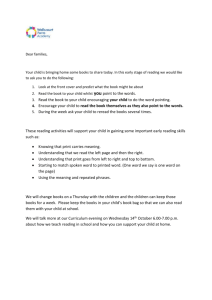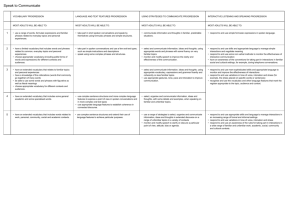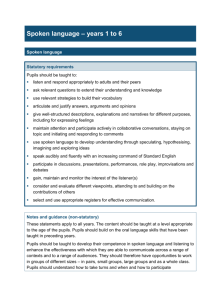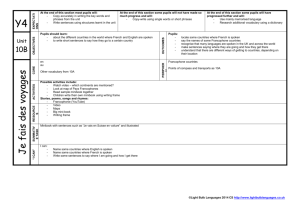Framework for Key Stage 3 Modern Foreign Languages
advertisement
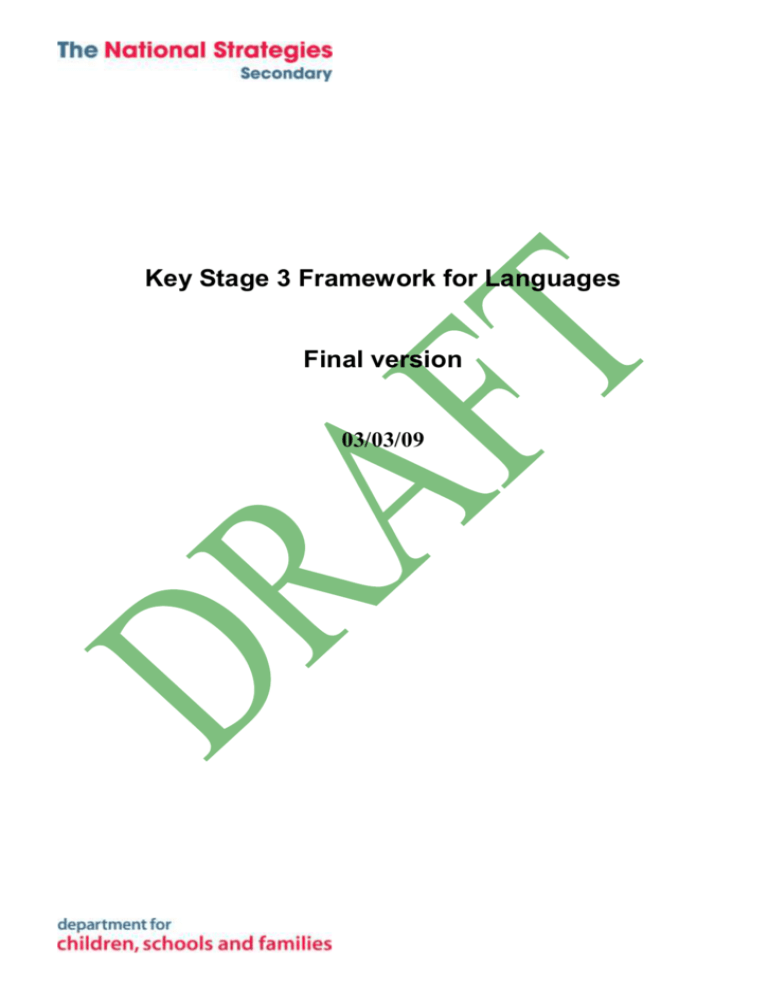
Key Stage 3 Framework for Languages Final version 03/03/09 The Framework 5 strands, 26 substrands, 34 objectives. Strands: 1. 2. 3. 4. 5. Listening and speaking (L&S) Reading and writing (R&W) Intercultural understanding (IU) Knowledge about language (KAL) Language learning strategies (LLS) To note: (i) The 5 strands link directly to the 5 strands of the Key Stage 2 framework. (ii) All objectives are year-specific except for the LLS objectives, which are relevant to all years. (iii) LLS objectives 1-5 are closely aligned with Part 2.1 of the new programme of study. Links to other key documents: The writing process has included checks against: the new Key Stage 3 programme of study; the new attainment target levels (Y7 levels 3-5; Y8 levels 4-6; Y9 levels 5-7+); the Key Stage 2 framework; the current Key Stage 3 framework. Framework objectives final version 03 03 09 2 STRAND 1: Listening and speaking (L&S) Contexts for learning in this strand should give pupils opportunities to explore aspects of the life and culture of countries and communities where the language is spoken. These could include people, places, festivals, national events, food, sport, history, education, climate, geographical features, buildings, the spoken and the written word, music and song, the visual arts and the media. Substrands 1.1 Understanding and responding to the spoken word 1.2 Developing capability and confidence in listening 1.3 Being sensitive to the spoken word 1.4 Talking together 1.5 Presenting and narrating Objectives Pupils should learn to: 1.1 Understanding and responding to the spoken word Y7 Y8 Y9 Identify gist and some detail in face-to-face exchanges, spoken passages, stories and songs Understand information at the first attempt, including language spoken at near-normal speed Understand longer sequences of speech, noting relevant points for oral feedback and discussion 1.2 Developing capability and confidence in listening Y7 Y8 Y9 Sustain perseverance and concentration when listening to speech containing some unfamiliar but accessible language in familiar contexts Sustain perseverance and concentration when listening to speech containing familiar language used in new contexts Listen to authentic speech from different sources, identifying how spoken language varies according to context and purpose Framework objectives final version 03 03 09 3 1.3 Being sensitive to the spoken word Y7 Y8 Y9 Interpret speakers’ intentions from intonation and tone of voice Explore how speakers use language for specific communicative functions Listen for language variation in formal and informal contexts Y7 Y8 Y9 Use intonation and tone of voice to convey mood and meaning Identify and use specific language for a range of communicative functions Adapt the degree of formality of language to suit different situations 1.4 Talking together Y7 Y8 Y9 Y7 Y8 Y9 Construct and generate language, using a stock of words, phrases and sentences for social communication and to talk about their work Initiate and participate in unrehearsed pupil-teacher and pupil-pupil exchanges Make extended and/or frequent contributions to classroom talk Make effective use of simple verbal or visual prompts in order to take part in conversations and discussions Plan and carry out unscripted conversations and discussions, taking into account the views, preferences and ideas of each group member Deal effectively with unexpected responses in order to sustain conversations and discussions 1.5 Presenting and narrating Y7 Y8 Y9 Y7 Y8 Y9 Plan and present a short talk or narrative, speaking clearly, audibly and with accurate pronunciation Use some complex language in a prepared but unscripted talk or narrative Respond quickly and appropriately to audience comments or questions following a talk or narrative Engage listeners’ attention through expression and non-verbal techniques Add authenticity through use of simple idioms Add interest through extended sentences, rhetorical devices and imaginative use of vocabulary Framework objectives final version 03 03 09 4 STRAND 2: Reading and writing (R&W) Contexts for learning in this strand should give pupils opportunities to explore aspects of the life and culture of countries and communities where the language is spoken. These could include people, places, festivals, national events, food, sport, history, education, climate, geographical features, buildings, the spoken and the written word, music and song, the visual arts and the media. Substrands 2.1 Understanding and responding to the written word 2.2 Developing capability and confidence in reading 2.3 Being sensitive to the written word 2.4 Adapting and building text 2.5 Writing to create meaning Objectives Pupils should learn to: 2.1 Understanding and responding to the written word Y7 Y8 Y9 Identify main points and some detail in written passages, stories and poems Develop their vocabulary through contact with authentic materials Identify and summarise evidence from text to support or refute a hypothesis 2.2 Developing capability and confidence in reading Y7 Y8 Y9 Y7 Y8 Y9 Use knowledge of word forms, syntax and context to engage with some unfamiliar but accessible language in a text Identify and understand familiar language in new contexts when reading longer and more complex texts Identify and describe features of language associated with different text types Select a text for personal reading and give reasons for their choice Give a personal response to a text, in terms of enjoyment or interest, supported by reference to the text itself Appraise texts quickly, deciding on their usefulness, interest and degree of difficulty, as a preliminary to independent reading Framework objectives final version 03 03 09 5 2.3 Being sensitive to the written word Y7 Y8 Y9 Recognise features used in a text for a specific effect Explore how language is used to evoke an emotive response in the reader Infer attitudes, feelings and points of view in a text by reading between the lines 2.4 Adapting and building text Y7 Y8 Y9 Use sentences and paragraphs as models for their own writing Use a story, poem or information text as a stimulus for their own writing Adapt a text for a different audience and purpose Y7 Use familiar structures and vocabulary to build short paragraphs of narrative and nonnarrative text Organise ideas and information into a sequence of paragraphs Link sentences and paragraphs using appropriate words and phrases in order to produce a coherent sequence of text Y8 Y9 2.5 Writing to create meaning Y7 Y8 Y9 Make effective use of familiar language in different text types Use language researched independently to add originality to their writing Experiment with linguistic devices and presentation to create an effect Framework objectives final version 03 03 09 6 STRAND 3: Intercultural understanding (IU) In strands 1 and 2 of the Framework contexts for learning should give pupils opportunities to explore aspects of the life and culture of countries and communities where the language is spoken. Work in these contexts will be complemented, strengthened and extended by the learning objectives of this strand. Substrands 3.1 Appreciating cultural diversity 3.2 Recognising different ways of seeing the world Objectives When learning about countries and communities where the language is spoken… Pupils should learn to: 3.1 Appreciating cultural diversity Y7 Y8 Y9 Investigate an aspect of life and compare with their own, noting similarities and differences Identify and explain an aspect of life that has changed over time Develop and communicate an in-depth understanding of an aspect of culture that they have identified and researched 3.2 Recognising different ways of seeing the world Y7 Y8 Y9 Y7 Y8 Y9 Explore interests and opinions of young people, and compare with their own Investigate aspirations of young people, recognising perspectives that are both similar to and different from their own Explain predominant beliefs and values, showing awareness of perspectives that may differ from their own Reflect on and challenge stereotypes Explain the origin and purpose of a custom that does not exist in their own culture Understand how attitudes towards other countries and reactions to world events may differ from those of their own culture Framework objectives final version 03 03 09 7 STRAND 4: Knowledge about language (KAL) Substrands 4.1 Letters and sounds 4.2 Words 4.3 Gender, number and other inflections 4.4 Sentence structure 4.5 Verbs and tenses 4.6 Questions and negatives Objectives Pupils should learn to: 4.1 Letters and sounds Y7 Y8 Y9 Apply knowledge of common letter strings, sound patterns, accents and other characters Identify and recall common exceptions to the usual patterns of sounds and spellings Identify the specific function or meaning of some letter strings 4.2 Words Y7 Y8 Y9 Build and use in new contexts a stock of high-frequency words and words relating to everyday settings Increase their stock of words, including a range of abstract items and words with more than one meaning Develop and refine their vocabulary by adding to their knowledge of word families and words with close meanings 4.3 Gender, number and other inflections Y7 Y8 Y9 Use knowledge of gender and plural forms to make changes to words and phrases Apply knowledge of gender and plural forms in their own writing and speaking Explore more complex points of inflection using reference materials if needed Framework objectives final version 03 03 09 8 4.4 Sentence structure Y7 Y8 Y9 Use knowledge of word order, high-frequency words and punctuation to understand and build simple and compound sentences Develop and improve sentences by adding, rearranging or replacing elements Use knowledge of word order, phrases and clauses to understand and build a wider range of extended sentences 4.5 Verbs and tenses Y7 Y8 Y9 Y7 Y8 Y9 Understand and use present tense forms of high-frequency verbs, and examples of past and other tense forms for set phrases Understand and use a range of verb forms referring to past, present and future events Recognise past, present and future verb forms and switch from one tense to another in speaking and writing Understand and use some high-frequency modal verb forms in simple statements and questions Understand and use a range of modal verb forms in different contexts Understand and use key past and future tense forms of modal verbs for set phrases 4.6 Questions and negatives Y7 Y8 Y9 Understand and use confidently some common question types in different contexts Understand and use a range of question types Make confident use of question types with simple and compound tenses Y7 Y8 Y9 Understand and use confidently some common negative forms in different contexts Understand and use a range of negative forms Make confident use of negative forms with simple and compound tenses Framework objectives final version 03 03 09 9 STRAND 5: Language learning strategies (LLS) Substrands 5.1 Identifying patterns in the target language 5.2 Memorising 5.3 Using knowledge of English or another language 5.4 Working out meaning 5.5 Using reference materials 5.6 Reading aloud 5.7 Planning and preparing 5.8 Evaluating and improving Objectives Pupils should learn to: 5.1 Identifying patterns in the target language Identify patterns of pronunciation, word formation, word order, grammatical structure and sentence structure in the target language 5.2 Memorising Discuss, compare and use a range of techniques for memorising words, phrases, structures and spellings 5.3 Using knowledge of English or another language Compare words, phrases, spellings, punctuation, sentence structure and grammatical structures in the target language with English and/or another language that they know well 5.4 Working out meaning Use previous knowledge, context and other clues to work out the meaning of what they hear or read Framework objectives final version 03 03 09 10 5.5 Using reference materials Make appropriate and effective use of reference materials to aid understanding, build vocabulary and develop speaking and writing 5.6 Reading aloud Read aloud written texts with increasing fluency, accuracy and expression, showing awareness of meaning 5.7 Planning and preparing Discuss and agree what needs to be known, understood and practised in order to carry out a task 5.8 Evaluating and improving Evaluate and improve the quality of their speech, their writing and their ability to understand the spoken and written word Framework objectives final version 03 03 09 11




